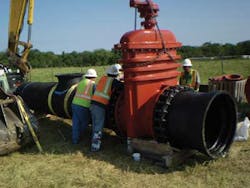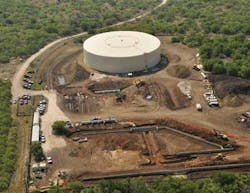| The South IH-35 Program includes 13 miles of water transmission main and three miles of wastewater interceptor. |
The City of Austin brought in URS as Program Management Consultant (PMC) to ensure the South IH-35 Program was successful. URS began with preliminary engineering design of 13 miles of water transmission main, three miles of wastewater interceptor, a 20 mgd pump station, and an elevated storage tank.
Pipeline Route
Determining the route of a pipeline is one of the most critical elements in the development of a linear infrastructure project. The cost and impact of the project are directly related to the quality and success of the routing process. The primary objective is to select a location that is cost-effective, environmentally appropriate, and meets the needs of the project.
Traditionally, potential routes are sketched on paper and a set of criteria is developed for the evaluation of those routes. Criteria generally include environmental hazards, physical barriers, challenging road crossings, a count of affected properties, and the length of the project area.
The handful of probable, or likely, routes are tweaked to avoid critical flaws and evaluated with a scoring matrix. Viable options are selected from a brief desktop study of real estate, rights-of-way, significant environmental features, highway crossings, and length. The potential routes are then evaluated in more detail. The elements of any scoring matrix vary by project and the needs of the owner but some general criteria are cost, environmental impacts, public disruption, number of required easements, and technical challenges. Each route is evaluated objectively and scored. The scores determine the route that best meets the overall needs of the project.
This method of routing evaluation has been employed for as long as water pipelines have been used to transport drinking water to the public. However, advances in technology have improved the evaluation process, and GIS has provided some of the most dramatic changes.
New Approach
GIS specialists and modelers at URS developed a GIS-enabled Suitability Model that was employed in the South IH-35 project. Once constituted, the model does the route analysis based on information provided by the modeler. The process begins with a map of all constraints that comprise the evaluation criteria for route analysis. These evaluation criteria are the same as those used in a traditional route analysis: cost, environmental impacts, public disruption, number of required easements, technical challenges, etc. Each criterion is assigned a suitability value based on a scale of 1 to 9, with 1 being the most suitable and 9 being the least suitable. Each criterion is then weighted based on project requirements, specific concerns, and values of the owner. Some features such as critical habitat or historic resources can be designated as avoidance criteria or "no-go" areas. All suitability criteria are summed to form a suitability surface.
From the suitability surface, an optimal path for the water pipeline is determined by applying an optimal path algorithm. By applying the algorithm, the model takes a stepwise approach between a starting and ending point and it proceeds to calculate the most suitable route between the points by evaluating the criteria from the suitability surface. The optimal path algorithm focuses on minimizing constraints (i.e., crossing streams) and maximizing opportunities (i.e., paralleling property boundaries or existing infrastructure) that were previously defined in the suitability model.




